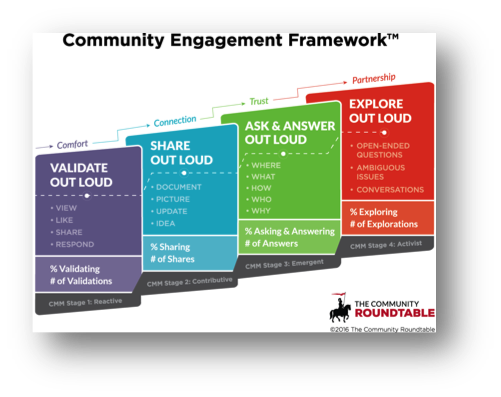It’s no secret that we’re huge fans of the work out loud concept. We’re in the middle of International Working Out Loud Week and are really enjoying all the great content this week at the #WOLWEEK site. If you’re thinking of how the #WOL movement can be applied specifically to community management, look no further! Below we have a round-up of some of our favorite work-out-loud resources we’ve previously featured.
Case Study: Using The Work-Out-Loud Framework To Measure Adoption & Engagement – We were lucky enough to have Jim Martin of Shepley Bulfinch facilitate a Roundtable Call with members of TheCR Network on how his organization used the Work-Out-Loud framework to measure adoption and engagement in their community.
On the call, Jim shared how he has been using the Work Out Loud (WOL) framework within Shepley Bulfinch. Specifically, Jim shared:
- How they are using Work-Out-Loud framework metrics to find validators, sharers, askers and answerers on their social intranet, and to better understand what they look like, and articulate the value their behavior has to the firm
- How they are using the framework to evaluate the success of their process for asking and answering technical questions; #AskFinch
- Why they chose this framework, what worked and what didn’t, and what they would do differently next time.
This case study specifically looks at an internal employee community use case, but was helpful for everyone facing engagement and adoption issues in their online communities.
TheCR Network Members can view the full case study here. Not a member? Join now.
The Link Between Communities and Culture Change – Most organizations do not understand how powerful communities can be in support of goals like creating collaborative and innovative cultures or executing on digital transformation.
When you take a community management approach to behavior change, it triggers a series of ‘aha’ moments for individuals that lead them to change their beliefs about what is possible – and leads to even more behavior change. Operationally, that means instead of investing in getting agreement on a new belief first, the belief becomes a natural result of engaging in new methods. The makes the community approach to culture change more cost-effective and agile.
 Community Engagement Framework – TheCR Community Engagement Framework gives structure to the process, and provides community managers with the goals and metrics they should focus on as their communities evolve.
Community Engagement Framework – TheCR Community Engagement Framework gives structure to the process, and provides community managers with the goals and metrics they should focus on as their communities evolve.
In each step, there are community management techniques to trigger, establish and reward the behaviors. For example, Sharing Out Loud can be triggered by having a regular thread where people share their priorities for the week, like we do in TheCR Network. That helps community members understand the social environment, get comfortable with how people respond to each other and engage without fear of demonstrating a lack of knowledge – making the community a more comfortable place for members to share.

